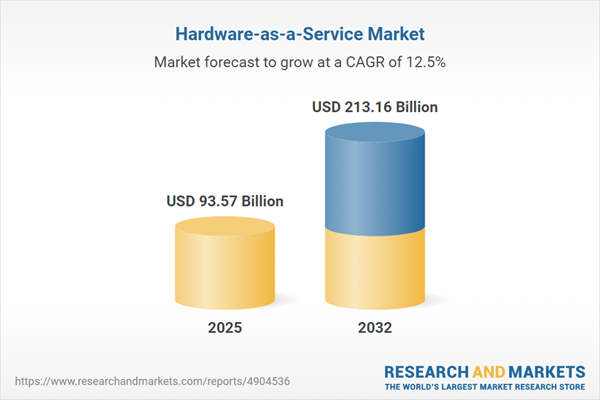Speak directly to the analyst to clarify any post sales queries you may have.
The hardware-as-a-service market is undergoing a rapid transformation as flexible, service-based consumption models reshape how organizations manage IT infrastructure. Senior decision-makers increasingly seek solutions that offer scalability and cost efficiency without traditional capital constraints.
Market Snapshot: Growth and Momentum in the Hardware-as-a-Service Market
The hardware-as-a-service market grew from USD 83.37 billion in 2024 to USD 93.57 billion in 2025. It is forecast to expand at a CAGR of 12.45%, reaching USD 213.16 billion by 2032. This significant growth underscores mounting enterprise demand for subscription-based IT procurement models amid accelerated digital transformation and evolving infrastructure needs.
Scope & Segmentation of the Hardware-as-a-Service Market
- Component: Endpoint Devices, Networking, Printing and Imaging, Security, Servers, Storage
- Deployment: Hybrid Cloud, Private Cloud, Public Cloud
- End-User Industry: Banking Financial Services and Insurance, Government and Defense, Healthcare, IT and Telecom, Manufacturing, Retail
- Organization Size: Large Enterprise, Small and Medium Businesses
- Geographic Coverage: Americas (United States, Canada, Mexico, Brazil, Argentina, Chile, Colombia, Peru), Europe, Middle East & Africa (United Kingdom, Germany, France, Russia, Italy, Spain, Netherlands, Sweden, Poland, Switzerland, United Arab Emirates, Saudi Arabia, Qatar, Turkey, Israel, South Africa, Nigeria, Egypt, Kenya), Asia-Pacific (China, India, Japan, Australia, South Korea, Indonesia, Thailand, Malaysia, Singapore, Taiwan)
- Key Technologies: Edge computing, artificial intelligence, managed security, analytics, circular economy initiatives
- Vendor Profiled: Hewlett Packard Enterprise Company, Dell Technologies Inc., Lenovo Group Limited, HP Inc., Cisco Systems, Inc., International Business Machines Corporation, Fujitsu Limited, Xerox Holdings Corporation, Ricoh Company, Ltd., Konica Minolta, Inc.
Key Takeaways for Senior Decision-Makers
- Hardware-as-a-service offers a flexible operational expenditure approach, enabling businesses to align IT costs with actual usage and evolving demand.
- This model shifts the responsibility for device maintenance, upgrades, and end-of-life management to service providers, reducing internal resource burdens.
- Sector-specific adoption reveals diverse requirements: financial services focus on high resilience, healthcare emphasizes device integration, and manufacturing prioritizes distributed edge deployments.
- Providers differentiate through managed analytics, integrated security, and performance guarantees, with new offerings for cloud-native, edge, and IoT-driven use cases.
- Collaboration among hardware suppliers, cloud platforms, and managed service providers accelerates deployment and creates seamless, customer-centric service ecosystems.
Tariff Impact: Navigating US 2025 Tariff Measures
New US tariff policies on semiconductors and network equipment are prompting hardware-as-a-service providers to adjust supply chains and contractual frameworks. Firms consider nearshoring and alternative sourcing partnerships to manage cost volatility and safeguard service reliability, particularly in industries with strict uptime needs. Strategic contract adjustments around tariffs support transparent pricing and help maintain customer trust across global deployments.
Methodology & Data Sources
This analysis combines primary interviews with senior enterprise IT and vendor leaders, review of industry publications, and validation using cross-referenced secondary sources. Expert roundtables supplement findings, and rigorous quality controls ensure the credibility and relevance of data presented.
Why This Report Matters
- Enables informed decision-making by detailing competitive dynamics and market drivers across components, deployments, and regions.
- Supports go-to-market and procurement strategies through in-depth analysis of technology innovation, regulatory influences, and emerging service models.
- Provides senior leaders with actionable insights to develop resilient, sustainable, and cost-effective IT infrastructure strategies aligned with market evolution.
Conclusion
The hardware-as-a-service market continues to evolve with flexible consumption, technological integration, and collaborative partnerships. Effective alignment of cost, risk, and operational agility will define future success for stakeholders navigating this dynamic landscape.
Additional Product Information:
- Purchase of this report includes 1 year online access with quarterly updates.
- This report can be updated on request. Please contact our Customer Experience team using the Ask a Question widget on our website.
Table of Contents
3. Executive Summary
4. Market Overview
7. Cumulative Impact of Artificial Intelligence 2025
Companies Mentioned
The companies profiled in this Hardware-as-a-Service market report include:- Hewlett Packard Enterprise Company
- Dell Technologies Inc.
- Lenovo Group Limited
- HP Inc.
- Cisco Systems, Inc.
- International Business Machines Corporation
- Fujitsu Limited
- Xerox Holdings Corporation
- Ricoh Company, Ltd.
- Konica Minolta, Inc.
Table Information
| Report Attribute | Details |
|---|---|
| No. of Pages | 197 |
| Published | October 2025 |
| Forecast Period | 2025 - 2032 |
| Estimated Market Value ( USD | $ 93.57 Billion |
| Forecasted Market Value ( USD | $ 213.16 Billion |
| Compound Annual Growth Rate | 12.4% |
| Regions Covered | Global |
| No. of Companies Mentioned | 11 |









